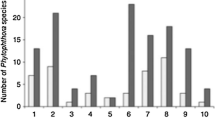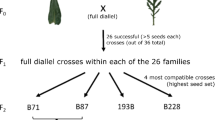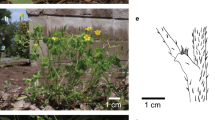Abstract
This review provides a summary of recent examples of interspecific hybridisation within the oomycetous genus Phytophthora. Species hybrids either created in the laboratory or evolved in natural environments are discussed in association with evolutionary issues and possible threats they may pose to agriculture, horticulture and forestry. It is suggested that sustainable control of such hybrids will depend on the better understanding of temporal and spatial aspects of genetic mechanisms and environmental factors that lead to the hybridisation process and thus the genetic diversity in Phytophthora populations.


Similar content being viewed by others
References
Bakonyi, J., Láday, M., & Érsek, T. (2002). Characterization of parental traits in somatic fusion progeny of Phytophthora infestans and Phytophthora nicotianae. Acta Phytopathologica et Entomologica Hungarica, 37, 33–46.
Bakonyi, J., Nagy, Z. Á., & Érsek, T. (2006). PCR-based DNA markers for identifying hybrids within Phytophthora alni. Journal of Phytopathology, 154, 168–177.
Bakonyi, J., Nagy, Z. Á., & Érsek, T. (2007). A novel hybrid with nuclear background of Phytophthora alni subsp. alni exhibits a mitochondrial DNA profile characteristic of P. alni subsp. uniformis. Acta Phytopathologica et Entomologica Hungarica, 42, 1–7.
Bates, M. R., Buck, K. W., & Brasier, C. M. (1993). Molecular relationship of the mitochondrial DNA of Ophiostoma ulmi and the NAN and EAN races of O. novo-ulmi determined by restriction fragment length polymorphisms. Mycological Research, 97, 1093–1100.
Boccas, B. R. (1981). Interspecific crosses between closely related heterothallic Phytophthora species. Phytopathology, 71, 60–65.
Bonants, P. J. M., Hagenaar-de Weerdt, M., Man in’t Veld, W., & Baayen, R. P. (2000). Molecular characterization of natural hybrids of Phytophthora nicotianae and P. cactorum. Phytopathology, 90, 867–874.
Brasier, C. M. (1992). Evolutionary biology of Phytophthora. Part I: Genetic system, sexuality and the generation of variation. Annual Review of Phytopathology, 30, 153–171.
Brasier, C. M. (2000). The rise of the hybrid fungi. Nature, 405, 134–135.
Brasier, C. M., Cooke, D. E. L., & Duncan, J. M. (1999). Origin of a new Phytophthora pathogen through interspecific hybridization. Proceedings of the National Academy of Sciences USA, 96, 5878–5883.
Brasier, C. M., & Jung, T. (2003). Progress in understanding Phytophthora diseases of trees in Europe. In J. McComb, G. Hardy, & I. Tommerup (Eds.), Proceedings, 2nd International Meeting of IUFRO Working Party 7.02.09, Albany, W. Australia 2001: Phytophthora in Forest and Natural Ecosystems (pp. 4–18). Perth, Australia: Murdoch University.
Brasier, C. M., & Kirk, S. A. (2001). Comparative aggressiveness of standard and variant hybrid alder phytophthoras, Phytophthora cambivora and other Phytophthora species on bark of Alnus, Quercus and other woody plants. Plant Pathology, 50, 218–229.
Brasier, C. M., Kirk, S. A., Delcan, J., Cooke, D. E. L., Jung, T., & Man in’t Veld, W. A. (2004). Phytophthora alni sp. nov. and its variants: Designation of emerging heteroploid hybrid pathogens spreading on Alnus trees. Mycological Research, 108, 1172–1184.
Brasier, C. M., Rose, J., & Gibbs, J. M. (1995). An unusual Phytophthora associated with widespread alder mortality in Britain. Plant Pathology, 44, 999–1007.
Burdon, J. J., Marshall, D. R., & Luig, N. H. (1981). Isozyme analysis indicates that a virulent cereal rust pathogen is a somatic hybrid. Nature, 293, 565–566.
Delcan, J., & Brasier, C. M. (2001). Oospore viability and variation in zoospore and hyphal tip derivatives of the hybrid alder Phytophthoras. Forest Pathology, 31, 65–83.
De Merlier, D., Chandelier, A., Debruxelles, N., Noldus, M., Laurent, F., Dufays, E., et al. (2005). Characterization of alder Phytophthora isolates from Wallonia and development of SCAR primers for their specific detection. Journal of Phytopathology, 153, 99–107.
Dick, M. W. (2002). Towards an understanding of the evolution of the downy mildews. In P. T. N. Spencer-Phillips, U. Gisi, & A. Lebeda (Eds.), Advances in Downy Mildew Research (pp. 1–57). Dordrecht: Kluwer.
English, J. T., Láday, M., Bakonyi, J., Schoelz, J. E., & Érsek, T. (1999). Phenotypic and molecular characterization of species hybrids derived from induced fusion of zoospores of Phytophthora capsici and Phytophthora nicotianae. Mycological Research, 103, 1003–1008.
Érsek, T., English, J. T., & Schoelz, J. E. (1995). Creation of species hybrids of Phytophthora with modifyied host ranges using zoospore fusion. Phytopathology, 85, 1343–1347.
Érsek, T., English, J. T., & Schoelz, J. E. (1997). Triparental species hybrids from fused zoospores of Phytophthora. Czech Mycology, 50, 13–20.
Erwin, D. C., & Ribeiro, O. K. (1996). Phytophthora diseases worldwide. St. Paul, MN: American Phytopathological Society Press.
Flor, H. H. (1932). Heterothallism and hybridization in Tilletia tritici and T. laevis. Journal of Agricultural Research, 44, 49–58.
Förster, H., & Coffey, M. D. (1991). Approaches to the taxonomy of Phytophthora using polymorphisms in mitochondrial and nuclear DNA. In J. A. Lucas, R. C. Shattock, D. S. Shaw, & L. R. Cooke (Eds.), Phytophthora (pp. 164–183). Cambridge: Cambridge University Press.
Gibbs, J. N., Lipscombe, M. A., & Peace, A. J. (1999). The impact of Phytophthora disease on riparian populations of common alder (Alnus glutinosa) in southern Britain. European Journal of Forest Pathology, 29, 39–50.
Goodwin, S. B., & Fry, W. E. (1994). Genetic analysis of interspecific hybrids between Phytophthora infestans and Phytophthora mirabilis. Experimental Mycology, 18, 20–32.
Gu, Y. H., & Ko, W. H. (2000). Segregation following interspecific transfer of isolated nuclei between Phytophthora parasitica and P. capsici. Canadian Journal of Microbiology, 46, 410–416.
Ioos, R., Andrieux, A., Marcais, B., & Frey, P. (2006). Genetic characterization of the natural hybrid species Phytophthora alni as inferred from nuclear and mitochondrial DNA analyses. Fungal Genetics and Biology, 43, 511–529.
Ioos, R., Husson, C., Andrieux, A., & Frey, P. (2005). SCAR-based PCR primers to detect the hybrid pathogen Phytophthora alni and its subspecies causing alder disease in Europe. European Journal of Plant Pathology, 112, 323–335.
Jung, T., & Blaschke, M. (2004). Phytophthora root and collar rot of alders in Bavaria: distribution, modes of spread and possible management strategies. Plant Pathology, 53, 197–208.
Layton, A. C., & Kuhn, D. N. (1988). Heterokaryon formation by protoplast fusion of drug-resistant mutants in Phytophthora megasperma f.sp. glycinea. Experimental Mycology, 12, 180–194.
Man in’t Veld, W. A. (2001). First report of natural hybrids of Phytophthora nicotianae and P. cactorum on loquat in Taiwan. Plant Disease, 85, 98.
Man in’t Veld, W. A., de Cock, A. W. A. M., & Summerbell, R. C. (2007). Natural hybrids of resident and introduced Phytophthora species proliferating on multiple new hosts. European Journal of Plant Pathology, 117, 25–33.
Man in’t Veld, W. A., Veenbaas-Rijks, W. J., Ilieva, E., de Cock, A. W. A. M., Bonants, P. J. M., & Pieters, R. (1998). Natural hybrids of Phytophthora nicotianae and Phytophthora cactorum demonstrated by isozyme analysis and random amplified polymorphic DNA. Phytopathology, 88, 922–929.
May, K. J., Drent, A., & Irwin, J. A. G. (2003). Interspecific hybrids between the homothallic Phytophthora sojae and Phytophthora vignae. Australasian Plant Pathology, 32, 353–359.
Nagy, Z. Á., Bakonyi, J., & Érsek, T. (2003). Standard and Swedish variant types of the hybrid alder Phytophthora attacking alder in Hungary. Pest Management Science, 59, 484–492.
Newcombe, G., Stirling, B., McDonald, S., & Bradshaw, H. D., Jr. (2000). Melampsora ×columbiana, a natural hybrid of M. medusae and M. occidentalis. Mycological Research, 104, 261–274.
Olson, Å., & Stenlid, J. (2001). Mitochondrial control of fungal hybrid virulence. Nature, 411, 438.
Olson, Å., & Stenlid, J. (2002). Pathogenic fungal species hybrids infecting plants. Microbes and Infection, 4, 1353–1359.
Sansome, E., Brasier, C. M., & Hamm, P. B. (1991). Phytophthora meadii may be a species hybrid. Mycological Research, 95, 273–277.
Schardl, C. L., & Craven, K. D. (2003). Interspecific hybridization in plant-associated fungi and oomycetes: A review. Molecular Ecology, 12, 2861–2873.
Streito, J.-C. (2003). Phytophthora disease of alder: Identification and distribution. In J. N. Gibbs, C. Van Dijk, & J. F. Webber (Eds.), Phytophthora disease of alder in Europe. Forestry Commission Bulletin, 126, 25–38.
Streito, J.-C., Legrand, P., Tabary, F., & Jarnouen de Villartay, G. (2002). Phytophthora disease of alder (Alnus glutinosa) in France: Investigations between 1995 and 1999. Forest Pathology, 32, 179–191.
Szabó, I., Nagy, Z., Bakonyi, J., & Érsek, T. (2000). First report of Phytophthora root and collar rot of alder in Hungary. Plant Disease, 84, 1251.
Whittaker, S. L., Assinder, S. J., & Shaw, D. S. (1994). Inheritance of mitochondrial DNA in Phytophthora infestans. Mycological Research, 98, 569–575.
Acknowledgements
Part of this study was supported by the Hungarian Scientific Research Fund (OTKA) grant K-61107. Special thanks are due to James T. English for critically reviewing the manuscript.
Author information
Authors and Affiliations
Corresponding author
Rights and permissions
About this article
Cite this article
Érsek, T., Nagy, Z.Á. Species hybrids in the genus Phytophthora with emphasis on the alder pathogen Phytophthora alni: a review. Eur J Plant Pathol 122, 31–39 (2008). https://doi.org/10.1007/s10658-008-9296-z
Received:
Accepted:
Published:
Issue Date:
DOI: https://doi.org/10.1007/s10658-008-9296-z




